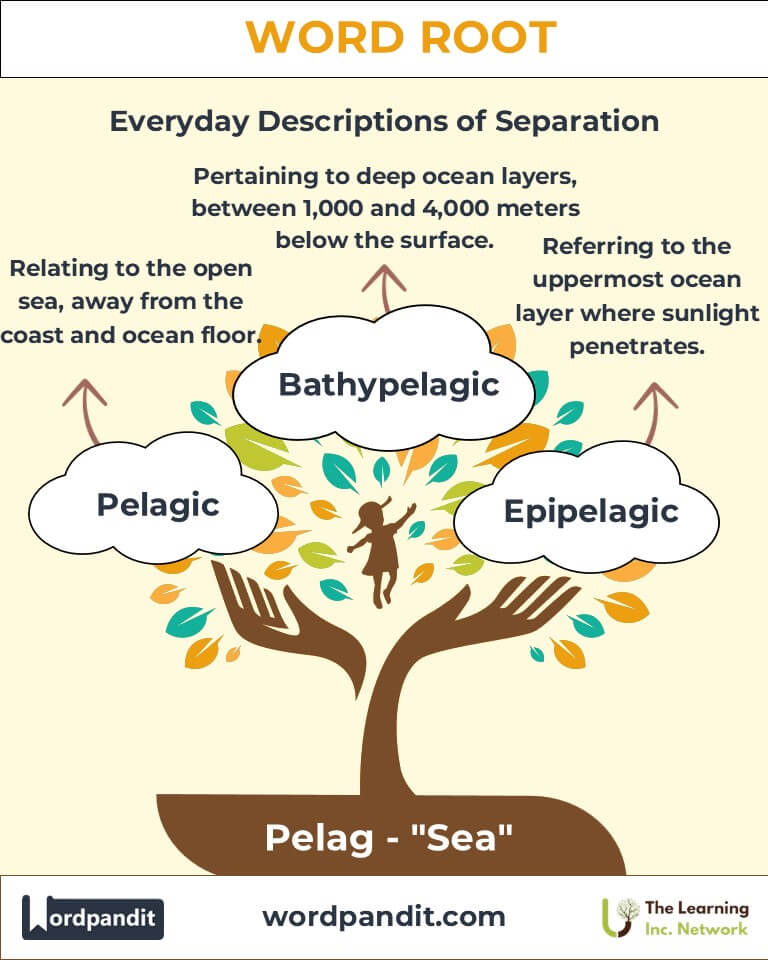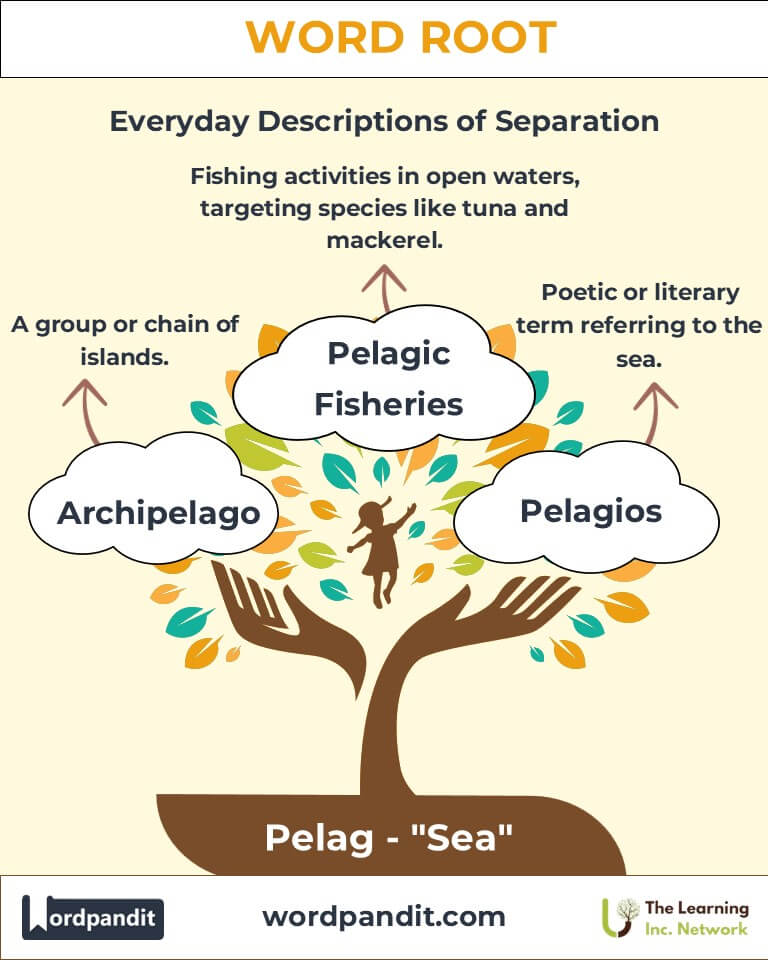Pelag: Exploring the Vastness of the Sea
Discover the depths of "Pelag," a word root derived from the Greek term for "sea." From scientific classifications to poetic descriptions of the ocean, "Pelag" has inspired a lexicon that connects humanity to the vast, mysterious waters that cover our planet.

Table of Contents
- Introduction: The Essence of Pelag
- Etymology and Historical Journey
- Mnemonic: Unlocking the Power of Pelag
- Common Pelag-Related Terms
- Pelag Through Time
- Pelag in Specialized Fields
- Illustrative Story: Pelag in Action
- Cultural Significance of the Pelag Root
- The Pelag Family Tree
- FAQs about the Pelag Word Root
- Test Your Knowledge: Pelag Mastery Quiz
- Conclusion: The Living Legacy of Pelag
1. Introduction: The Essence of Pelag
Imagine the endless horizon where the sea meets the sky. The word root Pelag, pronounced PEH-lag, comes from the Greek word pelagos, meaning "sea." It evokes images of boundless oceanic waters, maritime exploration, and the interconnectedness of life sustained by the seas. This root enriches terms that describe everything from oceanic zones to archipelagos, linking human understanding with the aquatic world.

2. Etymology and Historical Journey
"Pelag" has its origins in the Greek pelagos, signifying the vast, open sea. Ancient Greek civilizations, renowned for their maritime prowess, deeply understood the ocean's significance. Over time, the root evolved into words like pelagic, used in marine biology to describe organisms living in the open sea, and archipelago, referring to groups of islands. These terms highlight the linguistic journey of "Pelag" from classical Greece to modern scientific discourse.
3. Mnemonic: Unlocking the Power of Pelag
To remember Pelag, imagine a pelican soaring over the open ocean, symbolizing the vastness of the sea.
Mnemonic Device: "Pelag—Picture a pelican gliding over the pelagic waters of the endless sea."
4. Common Pelag-Related Terms
- Pelagic (puh-LAJ-ik): Relating to the open sea, away from the coast and ocean floor.
Example: "Pelagic fish, such as tuna, thrive in the deep, open ocean." - Archipelago (ahr-kuh-PEL-uh-go): A group or chain of islands.
Example: "The Greek archipelago is known for its breathtaking beauty and historical significance." - Epipelagic (eh-pee-puh-LAJ-ik): Referring to the uppermost layer of the ocean where sunlight penetrates.
Example: "Most coral reefs are found in the epipelagic zone." - Bathypelagic (bath-ee-puh-LAJ-ik): Pertaining to the deep ocean layers, typically between 1,000 and 4,000 meters below the surface.
Example: "Bathypelagic creatures often have bioluminescent adaptations to survive in darkness." - Pelagios (puh-LAJ-ee-os): Poetic or literary term referring to the sea.
Example: "The poet's verses were inspired by the serene beauty of Pelagios."
5. Pelag Through Time
- Ancient Origins: The term pelagos was widely used in ancient Greece to denote the open sea, crucial for trade and exploration.
- Scientific Expansion: By the 19th century, pelagic gained prominence in marine biology, categorizing aquatic organisms and ocean zones.
- Modern Adaptations: Today, pelagic extends into environmental science, describing the ecosystems of open waters and their role in Earth's climate regulation.
6. Pelag in Specialized Fields
- Marine Biology:
- Epipelagic Zone: The sunlit layer of the ocean, essential for photosynthesis and marine biodiversity.
- Application: Monitoring this zone helps track the health of marine ecosystems.
- Geography:
- Archipelago: Groups of islands formed by volcanic activity or rising sea levels.
- Application: Understanding archipelagos aids in studying tectonic activity and biodiversity hotspots.
- Environmental Science:
- Pelagic Fisheries: Fishing activities in open waters, targeting species like tuna and mackerel.
- Application: Sustainable management of pelagic fisheries ensures food security and marine conservation.
7. Illustrative Story: Pelag in Action
Dr. Marina Kostas, a marine ecologist, spent her career studying the epipelagic zone. On a research trip to the Mediterranean archipelago, she discovered a new species of bioluminescent plankton thriving in bathypelagic waters. This finding emphasized the intricate links between oceanic layers and biodiversity, inspiring her to advocate for the preservation of pelagic ecosystems.
8. Cultural Significance of the Pelag Root
The sea has inspired countless myths, poems, and artworks. From Homer’s Odyssey to modern maritime literature, the root Pelag symbolizes humanity’s fascination with the ocean’s mystery and power. Island nations, archipelagos, and maritime cultures draw their identities from the sea, further embedding Pelag in cultural heritage.

9. The Pelag Family Tree
Explore related roots and their meanings:
- Thalass- (Greek: "sea")
- Thalassocracy: Maritime dominance.
- Thalassotherapy: Seawater-based health treatments.
- Mar- (Latin: "sea")
- Mariner: A sailor.
- Marine: Relating to the sea.
- Naut- (Greek: "ship")
- Nautical: Pertaining to navigation or sailors.
- Astronaut: A sailor of the stars.

10. FAQs About the Pelag Word Root
Q: What does "Pelag" mean, and where does it come from?
A: Pelag means "sea" and originates from the Greek word pelagos. It specifically refers to the vast, open ocean, distinguishing it from coastal or inland waters. This root has inspired many terms in marine science, geography, and literature.
Q: What is the pelagic zone, and why is it important?
A: The pelagic zone refers to the open ocean, away from the coast and the sea floor. It includes multiple layers, such as the epipelagic (sunlit) and bathypelagic (deep sea) zones. This zone is crucial for marine ecosystems as it hosts a vast array of organisms, from plankton to large fish, that play key roles in Earth's carbon cycle and food webs.
Q: How does "Pelag" relate to islands?
A: The term "archipelago," derived from Pelag, refers to chains or clusters of islands. These formations often arise from tectonic or volcanic activity and are surrounded by vast open seas, emphasizing their connection to the ocean.
Q: What is the difference between "Epipelagic" and "Bathypelagic"?
A: The epipelagic zone is the uppermost ocean layer where sunlight penetrates, making it ideal for photosynthesis and rich in marine biodiversity. In contrast, the bathypelagic zone lies deep in the ocean, receiving no sunlight, and is characterized by high pressure and unique bioluminescent organisms adapted to the darkness.
Q: Why is the epipelagic zone essential for marine life?
A: The epipelagic zone, also known as the sunlight zone, supports photosynthesis, which produces oxygen and forms the base of marine food chains. It is home to phytoplankton, small fish, and larger predators, making it a hub of oceanic biodiversity.
Q: What does "archipelago" signify, and how is it formed?
A: An archipelago is a group of islands often formed through volcanic activity, tectonic plate movements, or rising sea levels. Examples include the Hawaiian Islands and the Maldives. The term underscores the connection between land and sea in geographic formations.
Q: Are there poetic or literary uses of "Pelag"?
A: Yes, terms like Pelagios have been used in poetry and literature to evoke the mystery and beauty of the open sea. These words highlight the ocean's cultural and artistic significance beyond scientific contexts.
11. Test Your Knowledge: Pelag Mastery Quiz
1. What does the root "Pelag" signify?
2. Which term describes the uppermost oceanic layer where sunlight penetrates?
3. What does the word "archipelago" describe?
4. What is the bathypelagic zone?
5. What is the origin of the root "Pelag"?

12. Conclusion: The Living Legacy of Pelag
The root Pelag connects language to the boundless sea, enriching our understanding of marine life, geography, and culture. As humanity explores and conserves the ocean, Pelag remains a vital part of the lexicon, inspiring awe and respect for the waters that sustain life on Earth. Dive into the wonders of "Pelag" and let it deepen your appreciation for the vast, mysteriou











